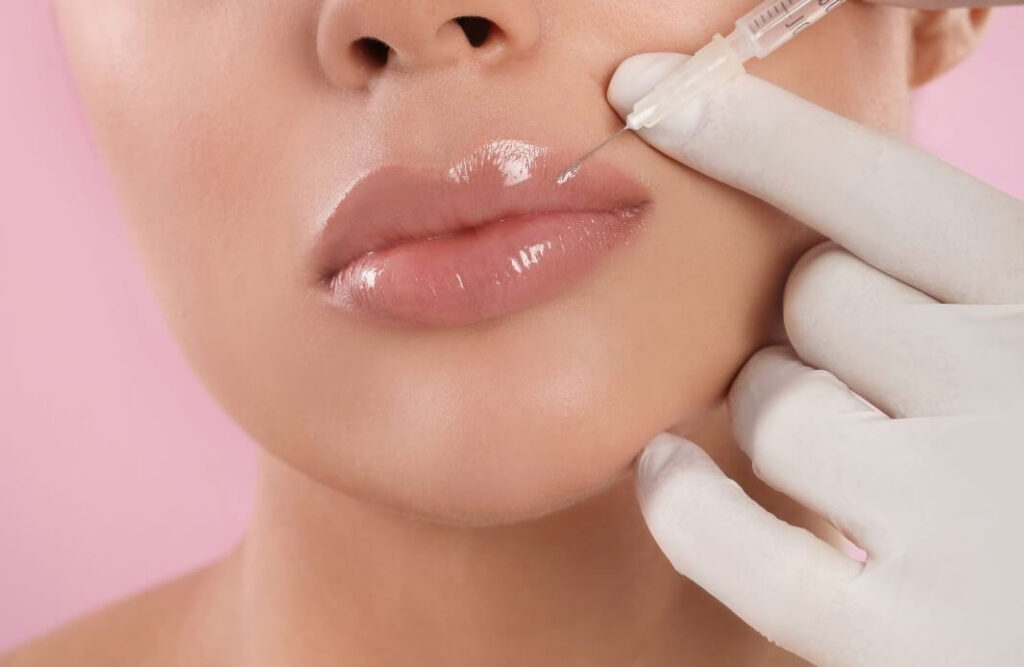Lip fillers have risen in popularity, offering a quick and effective way to achieve fuller, more defined lips.
Despite their widespread use, issues can arise post-procedure, ranging from mild to severe.
Understanding these potential problems and knowing how to address them can help allow for a positive experience and outcome.
Common issues include swelling, unevenness, overfilling, allergic reactions, migration, and infection.
This article aims to show you each of these issues, providing practical solutions and professional advice to maintain your lip filler results.
Swelling

Swelling is one of the most common reactions after lip filler injections.
It occurs as a natural response of the body to the needle and the filler substance.
Typically, swelling is most visible within the first 24 to 48 hours after the procedure and should gradually subside within a week.
To reduce swelling, you can apply cold compresses to your lips for short periods, making sure you don’t apply ice directly to the skin.
Staying hydrated by drinking plenty of water is also beneficial.
Over-the-counter anti-inflammatory medications can help reduce swelling but always consult with your healthcare provider before taking any medication.
If the swelling persists beyond a week or is accompanied by severe pain, bruising, or other symptoms, it could indicate an adverse reaction.
In such cases, seek professional advice promptly to address or prevent further lip filler problems.
Unevenness
Uneven lip filler results can be a source of frustration.
This unevenness can occur due to several factors, such as the natural asymmetry of the lips, uneven distribution of the filler, or swelling.
Initially, you might notice some asymmetry which often resolves as the swelling decreases.
Gentle massage can sometimes help redistribute the filler, but this should only be done if recommended by your practitioner.
Patience is key, as fillers can take up to two weeks to settle fully. If, after this period, you still notice unevenness, it may be worth consulting a professional.
They can examine your situation and recommend solutions such as adding more filler to balance the lips or using hyaluronidase injections to dissolve the excess filler.
It’s essential to follow professional advice to avoid making the problem worse.
Overfilling

Overfilling can result in an unnatural, overly plump appearance, often termed duck lips.
This issue typically arises when too much filler is injected during a single session. If you experience overfilling, the first step is to remain calm and allow the swelling to reduce, as some of the fullness might be due to temporary swelling.
To prevent overfilling, you need to have a thorough consultation with your practitioner, clearly communicating your desired outcome.
Start with a smaller amount of filler and build up gradually if necessary.
If overfilling occurs, professional intervention is often required.
Hyaluronidase injections can dissolve the excess filler, helping to restore a more natural appearance.
Regular follow-up appointments with your practitioner can help monitor the results and make any adjustments.
Allergic Reaction
Although rare, allergic reactions to lip fillers can occur. Symptoms of an allergic reaction include itching, redness, significant swelling, and, in severe cases, difficulty breathing.
If you experience any of these symptoms, seek medical attention immediately.
You need to inform your practitioner of any known allergies before undergoing the procedure, as fillers can contain various substances, including lidocaine, which is a common allergen.
To manage an allergic reaction, antihistamines or steroids may be prescribed by your healthcare provider.
In severe cases, emergency medical treatment may be necessary.
Understanding the ingredients in your fillers and choosing a reputable practitioner can help reduce the risk of allergic reactions.
Migration
Filler migration is a less common but concerning issue where the filler moves from the injection site to another area, leading to an uneven or lumpy appearance.
This can occur due to improper injection techniques, excessive movement of the treated area shortly after the procedure, or the natural properties of the filler.
Early signs of migration include lumps or unevenness outside the intended area.
To prevent migration, you need to follow aftercare instructions meticulously.
This typically includes avoiding strenuous exercise, not touching the treated area, and avoiding excessive facial movements for a few days post-procedure.
If migration does occur, professional correction is necessary.
Hyaluronidase injections can dissolve the migrated filler, allowing for a corrective approach to restore the desired appearance.
Infection
Infections post-lip filler treatment are rare but serious. Signs of an infection include severe pain, redness, swelling, warmth at the injection site, and sometimes fever.
Preventing infection begins with choosing a qualified practitioner who follows strict hygiene protocols.
Post-procedure, you need to maintain good hygiene, including not touching your lips with unwashed hands, avoiding makeup around the injection area, and following your practitioner’s aftercare tips diligently.
If you suspect an infection, seek medical help immediately.
Early treatment with antibiotics can prevent the infection from worsening.
In some cases, drainage procedures may be necessary to manage the infection effectively.
Proper aftercare and monitoring can significantly reduce the risk of post-procedure infections.
In conclusion, while lip fillers can significantly improve your appearance, being aware of potential issues and knowing how to address them is required.
Most problems, such as swelling, unevenness, overfilling, allergic reactions, migration, and infection, can be managed with proper care and professional guidance.
Remember as we have said to clearly follow aftercare instructions carefully, and don’t hesitate to consult with professionals for any concerns.
By staying informed and proactive, you can enjoy the benefits of lip fillers while minimising potential risks.





